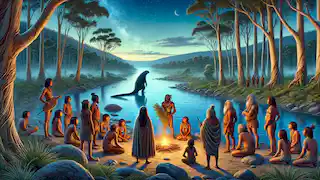The Story of the Bunyip
Reading Time: 16 min

About Story: The Story of the Bunyip is a Legend from australia set in the Ancient. This Descriptive tale explores themes of Nature and is suitable for All Ages. It offers Cultural insights. A tale of respect, courage, and the consequences of disturbing nature's balance.
In the deep heart of Australia, within the realms where the sun scorched the earth and the winds sang songs of ancient times, there were whispers of a creature so mysterious and powerful that it became the centerpiece of many tales told around the campfires of the Aboriginal tribes. This creature was known as the Bunyip, a being whose origins were as enigmatic as the creature itself. The story of the Bunyip is not just a tale of terror but a profound lesson about the intricate relationship between humans and the natural world. This story has been passed down through generations, told in the flickering light of fires and under the vast expanse of starry skies. To understand the story of the Bunyip, one must first understand the Dreamtime, the period of creation when the world was new, and the spirits of the ancestors roamed the land. The Dreamtime was a time when the earth was soft and malleable, a time when the actions of the ancestors shaped the landscape into the mountains, rivers, and plains that exist today. The Dreamtime was not just a period of history; it was a continuous, ever-present force that connected the past, present, and future. In those days, the land was a living entity, with every rock, tree, and waterhole infused with the spirit of the ancestors. The people who lived in this land understood that they were part of a greater whole, that their lives were intricately connected to the world around them. They knew that the spirits of the ancestors watched over them, guiding them and ensuring that they lived in harmony with the earth. Among the most revered of these spirits was Wandu, the guardian of the waterways. Wandu was a powerful and ancient being, a spirit whose essence flowed through every river, lake, and billabong. He was the lifeblood of the land, bringing water to the parched earth and sustaining all living things. The people worshipped Wandu, offering him gifts of food and song, and in return, he ensured that the rivers flowed with fresh, clean water and that the fish were plentiful. But Wandu was not just a gentle spirit; he was also a protector, a fierce guardian of the natural balance. He watched over the land with a keen eye, ensuring that the people respected the waterways and took only what they needed. For many years, the people lived in harmony with Wandu, and the land prospered. But as time passed, some began to forget the old ways, and the delicate balance was disturbed. In one tribe, nestled near a wide, slow-moving river that glistened under the harsh sun, a gradual change began to take place. The people of this tribe had always been careful to take only what they needed from the river, understanding that their survival depended on maintaining the balance between themselves and the natural world. But as the years went by, and as the tribe grew larger and more prosperous, they began to take the river's bounty for granted. Hunters, once careful and respectful, started to overfish, catching more than they could consume. They left the remains of their catches by the water's edge, attracting scavengers and fouling the water. The women, who gathered reeds and water plants for weaving and medicine, began to strip the riverbanks bare, leaving the land exposed and vulnerable to erosion. The children, who once played quietly by the river, now splashed and shouted, disturbing the animals that came to drink. Wandu, who had watched over the tribe for generations, observed these changes with growing concern. He saw the fish numbers dwindling, the water growing cloudy and polluted, and the once lush riverbanks turning barren. The people had forgotten the old ways, forgotten the respect they once had for the spirits of the land. And as they forgot, the land began to suffer. Wandu's heart, once filled with love for the people, began to harden. He could no longer watch as the land he had nurtured was destroyed by the very beings he had protected for so long. In his anger, Wandu decided to withdraw his spirit from the waterways, to leave the people to their fate. But he knew that without his protection, the river would die, and the people would suffer. He needed to teach them a lesson, a lesson they would never forget. In the stillness of the night, under a sky filled with stars, Wandu called upon the forces of the Dreamtime. He reached deep into the earth, pulling forth the dark energies that lay buried beneath the surface, energies that had been dormant since the beginning of time. From these energies, Wandu created a creature unlike any other—a creature born of anger, fear, and the poisoned waters of the river. This creature was the Bunyip. The Bunyip was a terrifying sight to behold. It had the body of a massive, sinewy beast, with powerful limbs that could crush a man in a single blow. Its skin was tough and rough, like the bark of an ancient tree, and its head was a grotesque amalgamation of features—a wide, gaping mouth filled with razor-sharp teeth, and eyes that glowed with an eerie, malevolent light. The Bunyip was a creature of the night, moving silently through the water, its presence felt long before it was seen. Wandu placed the Bunyip in the heart of the river, where it would wait, hidden beneath the surface, until the time was right. The Bunyip's purpose was simple: to protect the river by any means necessary. It would attack anyone who came too close, dragging them into the depths, where they would meet a terrible fate. The Bunyip would be a reminder to the people of the consequences of their actions, a symbol of the power of the spirits they had angered. It wasn't long before the people began to notice the changes in the river. The once lively waterway had become eerily silent. The fish that had once swarmed in its depths were gone, and the water, once clear and sparkling, had turned murky and foul. The animals that came to drink at the water's edge began to avoid the area, sensing that something was wrong. The tribe, too, felt the change, though they did not yet understand its cause. The first person to encounter the Bunyip was a young man named Maroo. Maroo was a skilled hunter, known for his bravery and his ability to track even the most elusive of prey. One evening, as the sun was setting and the sky was painted with shades of orange and red, Maroo went down to the river to fill his water skin. He had heard the stories of the strange happenings by the river, but he was not one to be easily frightened. He believed that the spirits of the land would protect him, as they always had. As Maroo knelt by the river's edge, dipping his water skin into the cool water, he felt a sudden chill run down his spine. The air around him seemed to grow heavy, and the usual sounds of the night—the chirping of insects, the rustling of leaves—fell silent. Maroo paused, his hand still in the water, and listened. In the distance, he heard a low, rumbling growl, unlike anything he had ever heard before. Before Maroo could react, the water before him erupted in a spray of droplets, and the Bunyip emerged from the depths. It rose up before him, a massive, shadowy figure, its eyes glowing with an unnatural light. Maroo barely had time to scream before the creature lunged at him, its powerful jaws snapping shut around his body. The Bunyip dragged Maroo into the water, and he was gone, his cries swallowed by the darkness. As the days passed, more and more people began to disappear. Those who ventured too close to the river at night never returned. The tribe was gripped by fear, and the once-thriving community fell into despair. The elders, who had always been the source of wisdom and guidance, were at a loss. They had never encountered anything like this before, and they did not know how to protect their people. The Bunyip's attacks grew bolder with each passing day. It no longer waited for nightfall to strike. It began to emerge from the water even during the day, attacking anyone who ventured too close. The tribe was paralyzed by fear, unable to fish, unable to gather water, unable to live their lives as they once had. The river, once a source of life and sustenance, had become a place of death and terror. The people began to wonder if they had angered the spirits of the land. They remembered the old stories, the tales of the Dreamtime, and they realized that they had strayed from the path that their ancestors had laid out for them. They had forgotten the teachings of the elders, forgotten the importance of living in harmony with the natural world. And now, they were paying the price. In their desperation, the people turned to the elders for guidance. The elders, though they were wise, could not provide the answers the people sought. They knew that the Bunyip was a creature of the spirits, a being born of the Dreamtime, and that it could not be defeated by ordinary means. But they also knew that they could not continue to live in fear. Something had to be done. In the midst of the growing fear and uncertainty, a young warrior named Naru emerged as a beacon of hope. Naru was known for his courage and strength, qualities that had earned him the respect of his peers and the admiration of the elders. He was a man of action, one who believed in facing challenges head-on rather than waiting for them to pass. When Naru saw the fear in the eyes of his people, he knew that he had to act. Naru approached the elders and offered to confront the Bunyip. He believed that if he could defeat the creature, he could restore peace to the tribe. The elders were hesitant, fearing for Naru's life, but they also knew that something had to be done. They gave Naru their blessing and prepared him for the journey ahead. Before setting out, Naru spent a night in solitude, meditating on the teachings of the Dreamtime. He visited the sacred site of the ancestors, a place where the spirits of the land were believed to dwell. There, Naru made offerings of food and sang the ancient songs that had been passed down through generations. As he sang, he felt a connection to the spirits, a sense of calm and purpose that filled him with strength. The next morning, as the first light of dawn touched the horizon, Naru set out towards the river. He carried with him the finest weapons the tribe had to offer—spears tipped with sharp stone, a shield made from the toughest wood, and a determination that burned bright in his heart. Naru knew that he was not just fighting for himself; he was fighting for his people, for the future of his tribe. As Naru approached the river, the land around him grew still. The usual sounds of the bush—birdsong, the rustling of leaves, the chatter of small animals—faded into silence. Even the wind seemed to hold its breath, as if the entire world was waiting to see what would happen next. Naru reached the water's edge and paused. The river, which had once been a place of life and vitality, now looked dark and foreboding. The surface of the water was still, reflecting the sky above like a mirror. But Naru knew that beneath that calm exterior, danger lurked. Taking a deep breath, Naru called out to the Bunyip. He shouted the creature's name, challenging it to show itself. For a moment, there was nothing but silence. Then, the water began to ripple, and a dark shape emerged from the depths. The Bunyip rose up before Naru, its massive form casting a long shadow over the land. The creature was even more terrifying than Naru had imagined. Its eyes glowed with an unnatural light, and its mouth, filled with sharp teeth, gaped open in a snarl. The Bunyip let out a roar that shook the ground, a sound that echoed across the river and sent chills down Naru's spine. But Naru did not back down. He raised his spear and charged at the Bunyip, his heart pounding in his chest. The creature lunged at him, its jaws snapping shut just inches from Naru's head. Naru dodged to the side and thrust his spear into the Bunyip's flank. The creature let out a howl of pain and turned on Naru with fury. As the battle continued, Naru began to feel the strain of the fight. His arms grew heavy, his breath came in ragged gasps, and his vision started to blur. The Bunyip, however, showed no signs of weakening. It kept coming, its eyes locked on Naru with a cold, calculating gaze. In that moment, Naru realized that he could not defeat the Bunyip through brute force alone. The creature was not just a physical being; it was a manifestation of the spirits, a product of the Dreamtime. No weapon, no matter how sharp or strong, could harm it. Naru lowered his spear and took a step back. The Bunyip paused, confused by the sudden change in its opponent. Naru raised his hands in a gesture of peace and began to speak to the creature, chanting the ancient words of the Dreamtime. He asked the spirits for forgiveness, not just for himself, but for his people. He acknowledged the wrongs they had done, the ways they had disrespected the land and the water. He promised that they would change, that they would return to the old ways, living in harmony with the natural world. As Naru spoke, the air around him seemed to change. The oppressive weight that had hung over the land lifted, and a sense of calm settled over the river. The Bunyip, which had been poised to strike, began to retreat. It sank back into the water, its glowing eyes never leaving Naru's face. Naru watched as the creature disappeared beneath the surface, the water growing still once more. He knew that the battle was over, but he also knew that the real challenge had just begun. The Bunyip had spared him, but it was up to the tribe to prove that they had learned their lesson. Naru returned to the tribe, exhausted but triumphant. The people gathered around him, eager to hear what had happened. Naru told them of his encounter with the Bunyip, of how he had fought the creature and how, in the end, he had realized that violence was not the answer. He spoke of the importance of respecting the spirits of the land, of living in harmony with nature, and of the need to restore the balance that had been lost. The people listened in silence, their fear replaced by a sense of awe. They understood now that the Bunyip was not just a monster to be feared, but a guardian of the natural world, a reminder of the power of the spirits they had angered. The elders, who had watched Naru's return with bated breath, nodded in agreement. They knew that the time had come to return to the old ways, to honor the teachings of the ancestors and to live in harmony with the land once more. That night, the tribe held a great ceremony to honor the spirits of the land. They gathered by the river, singing the ancient songs and offering gifts of food and water. The elders led the people in prayers of forgiveness, asking the spirits to cleanse the river and to restore its life-giving waters. As the ceremony continued, something miraculous happened. The water, which had been dark and murky, began to clear. The foul smell that had hung over the river faded, replaced by the fresh scent of clean water. The people watched in amazement as the river, once poisoned and lifeless, was renewed before their eyes. The tribe rejoiced, knowing that the spirits had heard their prayers and forgiven them. They vowed never to forget the lessons they had learned, to always respect the land and the water, and to live in harmony with the natural world. In the years that followed, the story of the Bunyip became a part of the tribe's history, passed down from generation to generation. The Bunyip was no longer seen as a monster, but as a guardian, a protector of the waterways and a symbol of the power of the spirits. The people knew that as long as they respected the land and the water, the Bunyip would remain a distant presence, watching over them from the depths of the river. The story spread to other tribes, who took the tale to heart. The Bunyip became a symbol of the importance of living in harmony with nature, a reminder of the consequences of neglecting the natural world. The people of the land learned to live with the Bunyip, not in fear, but in understanding. They knew that the creature was a part of the natural order, a manifestation of the spirits that guided and protected them. And so, the story of the Bunyip endured, a testament to the power of the Dreamtime and the importance of maintaining the balance between humans and the natural world. The Bunyip became a part of the land's mythology, a creature of both fear and respect, a symbol of the ancient wisdom that had been passed down through the ages. The story of the Bunyip is more than just a tale of a creature that terrorized a tribe; it is a profound lesson about the relationship between humans and nature. It teaches us about the importance of respect, humility, and the need to live in harmony with the world around us. The Bunyip is a reminder that we are all part of a greater whole, that our actions have consequences, and that the spirits of the land are always watching. In the end, the Bunyip is not just a creature of fear, but a guardian, a protector of the natural world. The lessons of the Bunyip are as relevant today as they were in the time of the ancestors—a reminder that we must live in harmony with nature, or face the consequences of our actions.The Dreamtime and the Creation of the Land
The Disruption of the Balance
The Birth of the Bunyip
The First Encounters

The Spreading Fear
The Decision to Act
The Confrontation

The Moment of Realization
The Return to the Tribe

The Legacy of the Bunyip

Conclusion



















